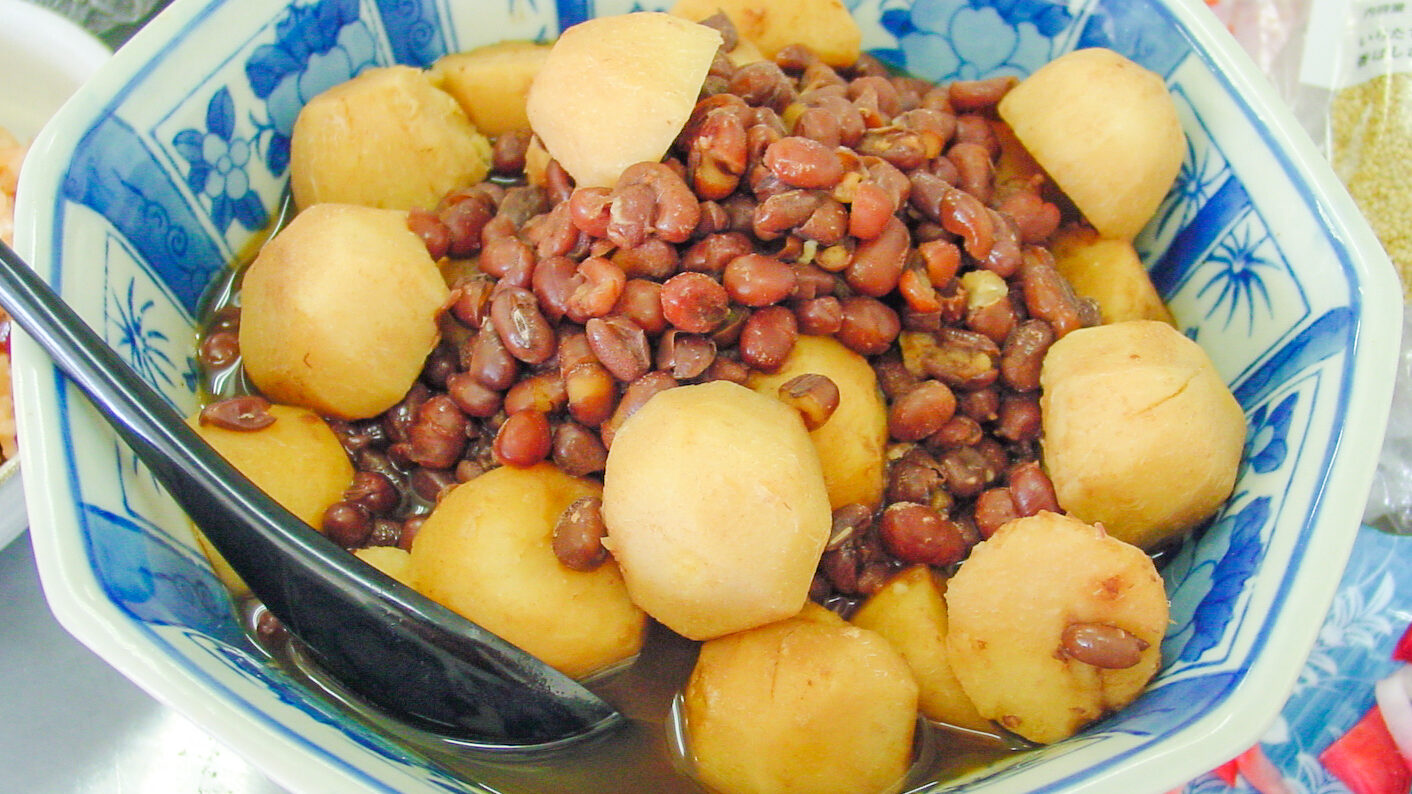
Alright, let’s explore a comforting and rustic dish from Shiga Prefecture: Itoko ni. It’s a simple yet flavorful combination of azuki beans and either taro or kabocha squash, simmered together. This dish has some interesting folklore and is tied to important events in the region, so let’s delve into its story.
Dish Name: Itoko ni (いとこ煮)
- Region / Location: Throughout Shiga Prefecture, especially in the Kohoku region
- Primary Area of Tradition: Throughout Shiga Prefecture, especially in the Kohoku region
- Main Ingredients: Azuki beans, taro, soy sauce
How It’s Eaten / Served
Azuki beans are boiled once, and the initial water is discarded to remove any bitterness. Then, they are boiled until tender. Taro root, cut into bite-sized pieces and parboiled, is added to the cooked azuki beans, along with sugar and soy sauce, and the mixture is simmered.
Cultural Background and Preservation
Itoko ni is a dish made by simmering azuki beans with either taro or kabocha squash. It’s a local dish that has spread throughout Shiga Prefecture, especially in the Kohoku region.
Itoko ni is often prepared for Hoonko services (Buddhist memorial services) and other Buddhist ceremonies to honor the memory of Shinran Shonin (a Buddhist monk). Itoko ni with kabocha squash is commonly eaten in the Koto region, while Itoko ni with taro root is more popular in the Kohoku region.
There are various theories about the origin of the name “Itoko ni.” One theory is that it comes from the way the ingredients are added to the pot in stages, with the longer-cooking ingredients added “oi oi” (gradually). Another theory suggests that it’s named after the family relationship “itoi to itoi” (nephew and nephew), while yet another theory proposes that it’s a variation of “itoku ni” (virtuous simmering).
In the winter solstice tradition, there’s a custom throughout Japan to eat kabocha squash and take yuzu baths. Itoko ni, using kabocha, is also commonly eaten during the winter solstice. Eating kabocha on the winter solstice, the shortest day of the year, is believed to help prevent colds and illness. Kabocha is a nutritious vegetable rich in beta-carotene, which the body converts into vitamin A. Azuki beans are a high-protein, high-fiber legume. In the past, people ate kabocha and azuki beans to aid recovery from illness and prevent disease.
Itoko ni is an indispensable dish for Hoonko services and Buddhist ceremonies. It’s also frequently eaten during the winter solstice, following the belief that eating azuki beans and kabocha squash on this day prevents illness.
Itoko ni is still made in homes today and is also served in school lunches, making it a familiar dish to the younger generation.
Additional information:
- Itoko ni (いとこ煮): A simmered dish of azuki beans and either taro or kabocha squash.
- Azuki (小豆): Small red beans commonly used in Japanese cuisine, especially in sweets.
- Taro (里芋): A root vegetable with a slightly sticky texture when cooked.
- Kabocha (かぼちゃ): A Japanese pumpkin, known for its sweetness and dense texture.
- Hoonko (報恩講): Buddhist memorial services held to commemorate the founder of the Jodo Shinshu sect, Shinran Shonin.
- Winter Solstice (冬至): The day with the shortest period of daylight and the longest night of the year.
- Yuzu (柚子): A Japanese citrus fruit known for its aromatic peel.
- Beta-carotene (β-カロテン): A pigment found in plants that the body converts into vitamin A.
The information about regional cuisine featured on this website (Piggy's Grandma of Japan) is summarized and adapted from the Ministry of Agriculture, Forestry and Fisheries of Japan (MAFF) website, "Our Regional Cuisines"Additional commentary is provided based on the unique experiences and perspectives of the site's editors.
The copyright for the original content regarding regional cuisine belongs to the Ministry of Agriculture, Forestry and Fisheries of Japan.
The summaries and adaptations published on this site are intended for informational purposes only. Piggy's Grandma of Japan does not guarantee the accuracy or completeness of this information. For the most accurate and complete details, please refer to the original pages on the MAFF website.

